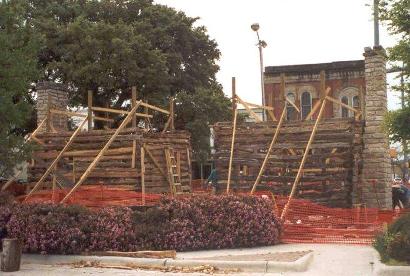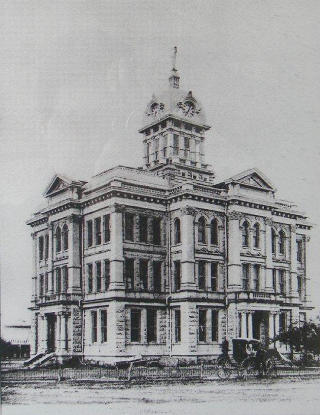|
The 1939 Comanche
County Courthouse
Photo courtey Terry
Jeanson, 2007 |
|
Typical of Texas,
Comanche County
has had several courthouses and two of them remain on the square
in Comanche. The current Art Deco
structure was designed by the late Wyatt Hendrick of Fort
Worth whose architectural achievements receive recognition even
today. The three-story building, begun in 1939 and dedicated in
the fall of 1941, was built with very substantial W.P.A. funding
plus local bond money. Its external appearance remains little changed
aside from a few additions to meet A.D.A. requirements. Limestone
from a local quarry was used and some material from the razed
1891 courthouse went into interior walls. The heroic-sized cut
stone eagles that accent the north and south entrances were made
on site by the late Elmer Webb, a Comanche stone cutter.
|
"Old
Cora"
- First Comanche County courthouse
Postcard courtesy www.rootsweb.com/ %7Etxpstcrd/ |
|
The little log
structure that served Comanche
County at Cora, its original
county seat, is on the southwest
corner of the square. It has been on five different sites between
1856 and 1983. The west room reputedly was Comanche's courthouse
between 1856 and 1858. Later the one room was moved and placed with
another log structure to become a double pen cabin with its typical
dog trot center hall. For many years this building, used as a residence,
was on a knoll beside the road slightly removed from the old Cora
town site and overlooked the Leon River.
Local citizens raised funds in 1938 to move the building to a new
location about four miles south of Comanche.
There it overlooked Lake Eanes, the city-owned water supply with
its adjoining park. Deterioration set in as years passed. About
1961, Burks Museum in Comanche received permission to move the building
to their private museum grounds and repair it. As Mr. and Mrs. A.
P. Burks aged, the privately owned museum was sold. The Comanche
Historical Commission wrestled possession of Cora
out of the sale transactions and relocated it to the square. Under
the auspices of the Old Cora Commission restoration work was completed
during 1984 with an historical
marker for Cora dedicated in 1986 public ceremonies as a Texas
Sesquicentennial event. New, serious, very substantial restoration
efforts continue in 2002-2003 involving a grant from the Texas Department
of Transportation with other funding still needed. The plans afoot
include extensive changes to the entire south
side of Comanche's
square.
|
 |
|
Comanche
County
has had five different courthouses.
Briefly listed they are the log
cabin at Cora and a picket construction
log courthouse built at Comanche about 1859. This cabin built of
logs set upright in a trench and placed tightly together "burned
on the night of March 15, 1862" according to Commissioners Court
minutes.
Afterward, the county had no formal edifice until it commissioned
a two story structure built by the new contracting firm of Martin,
Byrne, & Johnston and completed in 1876. This building, set in the
middle of the square with a north and south orientation, was of
locally made red brick with cut stone trim. It served until the
close of the 1880s.
|
| 1875
Comanche County Courthouse |
"In 1859,
after the move from Cora to Comanche,
the county conducted its business in a one-room building made of pickets,
logs placed side by side vertically in a trench. This type of building,
used for forts and other utilitarian structures across the South from
1770 to 1860, was not intended to last, and its destruction by fire
on March 20, 1862, was noted without comment in the minutes of the
Comanche County
Court. The county rented Silas Pickett’s building and made plans to
build a two-story structure fifty feet square “of hewn stone and good
plank.”
Twelve years passed before the construction of the courthouse was
begun by William Martin, D. C. Byrne and J. J. Porter. The new courthouse,
completed in 1875, was a remarkable post-war example of the persistence
after 1865 of a building type fashionable across the South in the
1820s. The segmental window bands in the first story and the brackets
under the eaves were distinctive signs of the seventies, but apart
from these details the Courthouse of 1875 was the hip-roofed, two-story
building with belfry and symmetrically placed windows that was built
in Virginia, Georgia and Tennessee in the age of Jefferson."
- Photo and information from the Old Cora Interpretive Exhibit : Comanche
County 1986 Sesquicentennial Committee. - Terry
Jeanson |
 |
| 1890 Comanche
County Courthouse |
| "By 1890,
the brick building of
1875 was too small, too old-fashioned, for the growing town of
Comanche, and the Austin
architectural firm of Larmour & Watson was employed to design a new
building. The three-story stone courthouse, designed in an elegant
combination of Second Empire and Renaissance Revival styles, was a
fitting symbol of Comanche
County at the height of its successes in agriculture and later
in oil and peanuts." - Photo and information from the Old Cora
Interpretive Exhibit : Comanche
County 1986 Sesquicentennial Committee - Terry
Jeanson |
"This
impressive three story building with its tower, striking clock, and
clear-sighted Statue of Justice was a landmark between 1891 and 1939"
Razed
Photo
courtesy texasoldphotos.com |
| When
the railroad finally approached Comanche and economic times improved,
Austin architects, Lamour
& Watson, were commissioned to design Comanche
County's handsomest public structure. This impressive three story
building with its tower, striking clock, and clear-sighted Statue
of Justice was a landmark between 1891 and 1939. It was razed and
the space used to build the new Art Deco structure. A very similar
building, almost a twin to the 1891 Comanche Courthouse, can be seen
in Cameron
today where Milam
County has done a beautiful restoration of their 19th century
courthouse. |
The present Comanche
County Courthouse
1940 photo courtesy TXDoT |
Comanche County
Courthouse Eagle
Photo courtey Terry
Jeanson, 2007 |
The
battered Statue of Justice, meticulously repaired by Cliff Conway,
can be seen in the main hall of Comanche's
courthouse. Incidents over time have left her without her scales that
are thought to have been lost in a windstorm and were missing by 1908.
Subsequent damage after her removal from the razed 1891 building includes
a missing forearm, hand, and the symbolic Sword of Justice. There
are some bullet holes courtesy of a long ago target shooter. Most
unusual is the absence of the traditional blindfold that may allow
Comanche's Justice to look carefully
at any issue with both eyes. A well preserved example of the same
statue can be seen on the Coryell
County courthouse at Gatesville
today.
© Margaret T. Waring
2003
Book Hotel Here › Comanche
Hotels |
|
|
